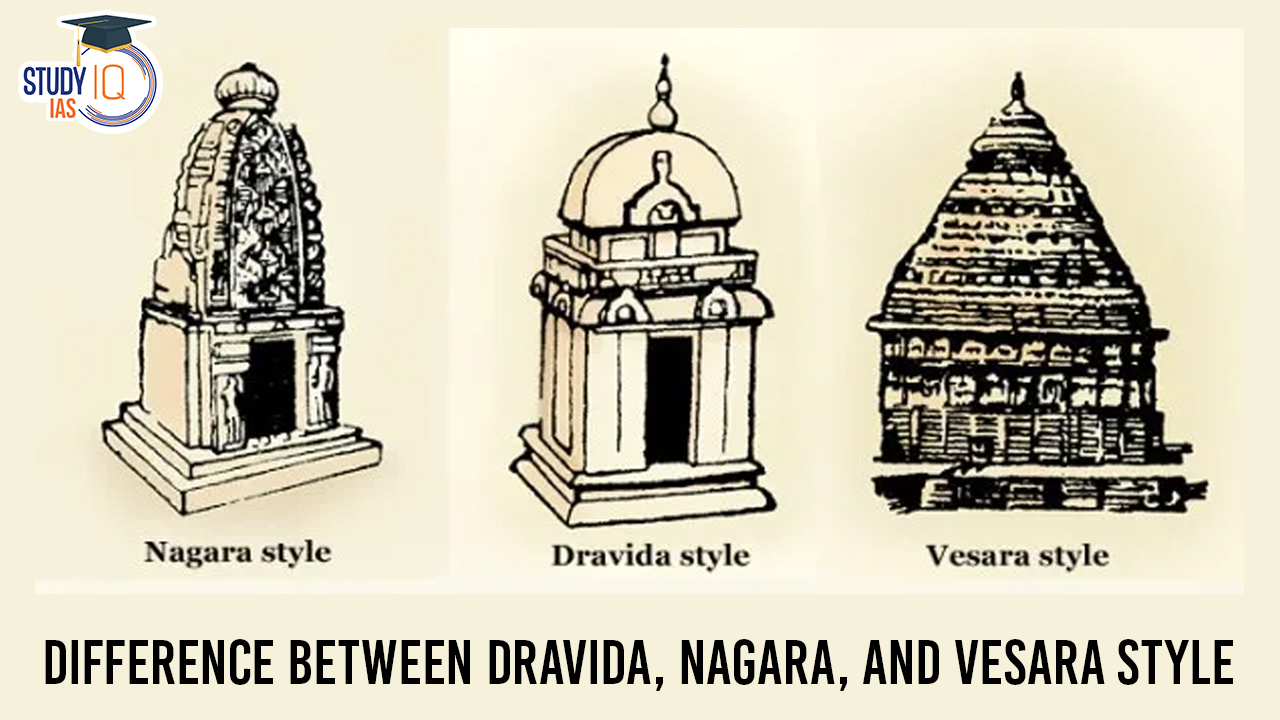Table of Contents
Dravida, Nagara, and Vesara are distinct architectural styles in Hindu temple design. Dravida, prevalent in southern India, features pyramidal towers with multiple storeys. Nagara, found in the north, showcases curvilinear towers with pointed apices and multiple entrances. Vesara is a blend of both, incorporating elements from Dravida and Nagara styles, resulting in a hybrid architecture. Examples of Dravida include the Brihadeshwara and Meenakshi Temples, while Nagara is exemplified by the Kandariya Mahadeva and Lingaraj Temples. The Hoysala temples in Karnataka, such as Chennakesava and Hoysaleswara, illustrate the Vesara style, reflecting a harmonious fusion of regional influences.
We’re now on WhatsApp. Click to Join
Temple Architecture in India
In the early Vedic period, temples were absent, and worship primarily centered around the sacred fire, known as “yajnas.” However, during the later Vedic period, the practice of idol worship emerged alongside the continued significance of ritual fires. Initially, rudimentary temples may have consisted of simple earth mounds, eventually giving way to more sophisticated structures made of bricks with grass roofs.
Before the establishment of distinct architectural styles, early Indian temples can be categorized into three types: Nirandhara (with Pradakshinapatha), Sandhara (without Pradikshinapatha), and Sarvatobhadra (accessible from all sides). Notable temples from this era, such as those at Eran, Nachna-Kuthara, Udaygiri in Madhya Pradesh, and Deogarh in Uttar Pradesh, provide insights into the evolving architectural and religious practices of ancient India.
Types of Temple Architecture in India
The Gupta Period ushered in a transformative era in temple architecture, accompanied by the emergence of architectural treatises known as Shilpashastras during the early medieval period. This architectural evolution gave rise to three predominant styles of temple construction:
- Dravida Style: Characterized by its prevalence in southern regions, Dravida style features pyramidal towers with multiple storeys, exemplified by temples like the Brihadeshwara Temple in Thanjavur.
- Nagara Style: Prominent in the northern parts of India, Nagara style is distinguished by its curvilinear or beehive-shaped towers and multiple entrances, as seen in temples like the Kandariya Mahadeva Temple in Khajuraho.
- Vesara Style: Representing a synthesis of Dravida and Nagara elements, Vesara style showcases a blend of architectural features from both traditions, evident in temples such as the Hoysaleswara Temple in Halebidu.
These architectural styles collectively highlight the diverse and rich heritage of temple construction during this period.
Difference between Dravida, Nagara, and Vesara Style
| Aspect | Dravida Style | Nagara Style | Vesara Style |
| Region | Southern India | Northern India | Synthesis of Dravida and Nagara styles |
| Vimana (Tower) | Pyramidal with multiple storeys | Curvilinear or beehive-shaped with pointed apex | Combination of features from Dravida and Nagara |
| Mandapa | Often includes a pillared hall | May have a flat roof or simple pyramidal form | Reflects a mix of regional architectural elements |
| Entrance | Typically single, facing east | Multiple entrances, often with elaborate gateways | – |
| Examples | Brihadeshwara Temple in Thanjavur, Meenakshi Temple in Madurai | Kandariya Mahadeva Temple in Khajuraho, Lingaraj Temple in Bhubaneswar | Hoysala temples like Chennakesava Temple in Belur, Hoysaleswara Temple in Halebidu |
| Characteristics | – Tower narrows as it rises | – Towers often intricately carved | – Exhibits a harmonious fusion of Dravida and Nagara styles |
| Period of Prevalence | Primarily during the Chola dynasty and subsequent periods | Predominant during the early medieval period | Prominent during the Hoysala dynasty and beyond |
Dravida, Nagara, and Vesara are architectural styles associated with Hindu temple architecture in India. These styles reflect regional and cultural variations in the design and construction of temples. Here’s a brief overview of each:
Dravida Style
- Region: Primarily associated with the southern part of India.
- Characteristics:
- Vimana (Tower): Dravida temples typically have a pyramidal tower (shikhara or vimana) with multiple storeys, each marked by a horizontal molding. The tower becomes narrower as it rises.
- Mandapa: The temple often includes a pillared hall called the mandapa.
- Entrance: Usually, there is a single entrance that faces the east.
- Examples: The Brihadeshwara Temple in Thanjavur and the Meenakshi Temple in Madurai are prominent examples of Dravida architecture.
Nagara Style
- Region: Mainly associated with the northern part of India.
- Characteristics:
- Vimana (Tower): Nagara temples typically have a curvilinear or beehive-shaped tower with a pointed apex.
- Mandapa: The mandapa in Nagara temples may have a flat roof or a simple pyramidal form.
- Entrance: Temples often have multiple entrances, and the main entrance is often adorned with an elaborate gateway (torana).
- Examples: The Kandariya Mahadeva Temple in Khajuraho and the Lingaraj Temple in Bhubaneswar exhibit Nagara architectural style.
Vesara Style
- Blend of Dravida and Nagara:
- Vesara is a hybrid or mixed style that combines elements of both Dravida and Nagara styles.
- Characteristics:
- May have a tower that combines features of both the Dravida and Nagara styles.
- Exhibits a mix of regional architectural elements.
- Examples: The Hoysala temples in Karnataka, such as the Chennakesava Temple in Belur and the Hoysaleswara Temple in Halebidu, are often considered examples of the Vesara style.
Difference between Dravida, Nagara, and Vesara Style UPSC
Dravida, Nagara, and Vesara are distinct Hindu temple architectural styles. Dravida, prevalent in Southern India, features pyramidal towers with multiple storeys. In Northern India, Nagara exhibits curvilinear towers with pointed apices and elaborate entrances. Vesara represents a blend, incorporating features from both Dravida and Nagara styles. Dravida’s hallmark is the tower narrowing as it rises, Nagara’s intricate carvings on beehive-shaped towers, and Vesara’s harmonious fusion. Examples include the Brihadeshwara Temple, Kandariya Mahadeva Temple, and Hoysaleswara Temple, showcasing the cultural diversity and evolution of temple architecture across India.


 Chakma and Hajong Communities: History, ...
Chakma and Hajong Communities: History, ...
 Sheesh Mahal in Delhi Restoration, Archi...
Sheesh Mahal in Delhi Restoration, Archi...
 Bonalu Festival 2025: Date, History, Rit...
Bonalu Festival 2025: Date, History, Rit...





















